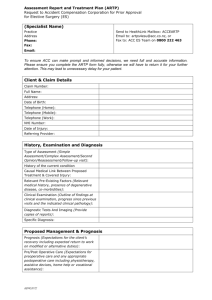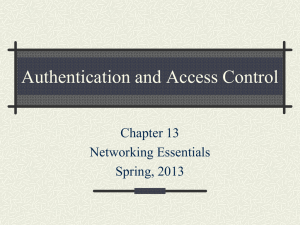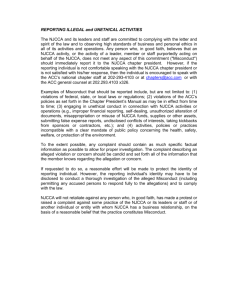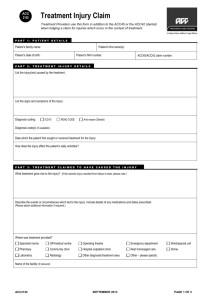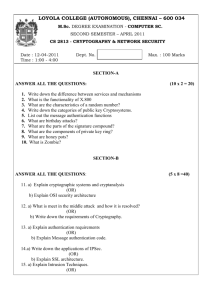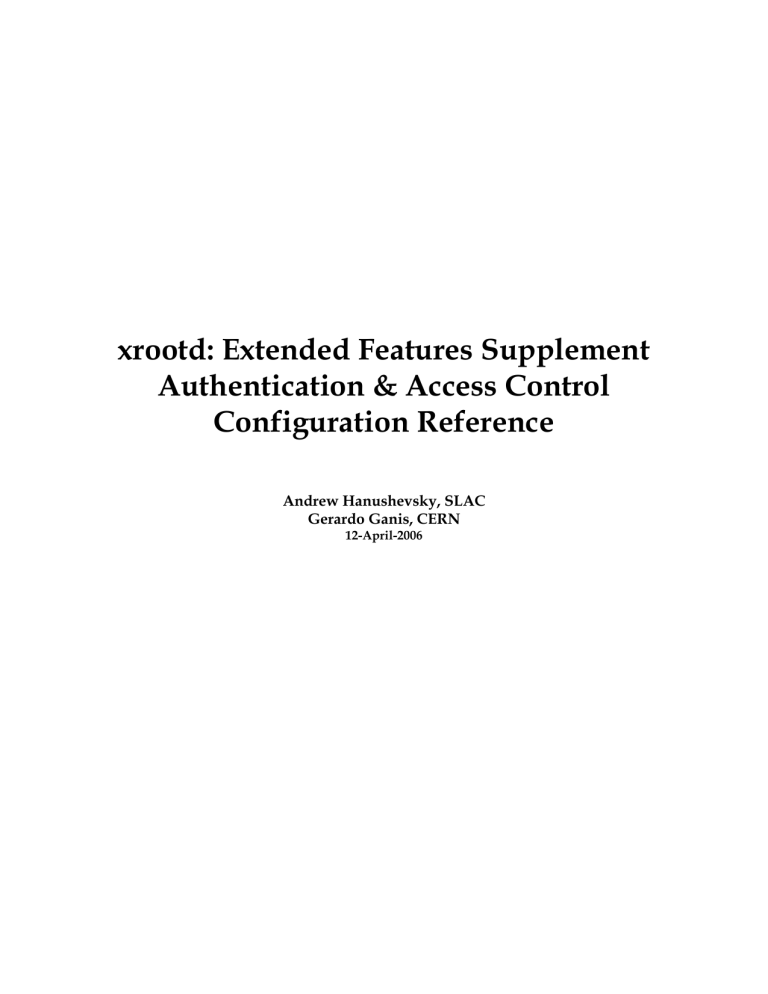
xrootd: Extended Features Supplement
Authentication & Access Control
Configuration Reference
Andrew Hanushevsky, SLAC
Gerardo Ganis, CERN
12-April-2006
©2005 by the Board of Trustees of the Leland Stanford, Jr., University
All Rights Reserved
Produced under contract DE-AC03-76-SFO0515 with the Department of Energy
This code is available under a BSD-style license allowing minimally restricted use.
ii
1-June-2005
sec & acc Configuration
Security
1
Introduction ............................................................................ 5
1.1
2
3
Contents
Client/Server Deployment ........................................................... 6
Specifying Conditional Directives ..................................... 7
Authentication Configuration ............................................. 9
3.1
3.2
protbind ........................................................................................... 9
protocol .......................................................................................... 11
3.2.1
protocol (host)......................................................................................... 12
3.2.2
protocol (gsi) ........................................................................................... 13
3.2.2.1 Configuring GSI Security ............................................................... 15
3.2.2.2 xrdgsiproxy ......................................................................................... 19
3.2.3
protocol (krb4) ........................................................................................ 20
3.2.3.1 Configuring Kerberos IV Security ................................................ 21
3.2.4
protocol (krb5) ........................................................................................ 22
3.2.4.1 Configuring Kerberos V Security .................................................. 23
3.2.5
protocol (pwd) ........................................................................................ 24
3.2.5.1 Configuring pwd Security............................................................... 27
3.2.5.2 xrdpwdadmin..................................................................................... 29
3.3
4
Authorization Configuration............................................. 33
4.1
4.2
4.3
4.4
4.5
4.6
4.7
5
audit ............................................................................................... 33
authdb ............................................................................................ 34
authrefresh .................................................................................... 35
gidlifetime ..................................................................................... 36
gidretran ........................................................................................ 37
nisdomain ...................................................................................... 38
pgo .................................................................................................. 39
Authorization Database File .............................................. 41
5.1
5.1.1
5.1.2
6
protparm ........................................................................................ 31
Authorization Database Record ................................................ 42
Default Privileges ................................................................................... 45
User Fungible Capabilities.................................................................... 45
Document Change History ................................................ 46
sec &acc Configuration
1-June-2005
iii
Security
Authentication
1 Introduction
This document describes the configuration of the security and access control
components of the extended root daemon (xrootd). The xrootd consists of five
configurable components (un-shaded components are documented in this
reference):
Component
sec
acc
ofs
oss
odc
olb
Purpose
Security authentication
Access control (i.e., authorization)
Open file system coordinating acc, odc, & oss components
Open storage system (i.e., file system implementation)
Open distribute cache
Open Load Balancing
Configuration directives for each component come from a configuration file. The
xrootd structure forces that all components read their directives from the same
configuration file. This is the configuration file specified when xrootd was started
(see the –c option xrootd option). This is possible because each component is
identified by a unique 3-letter prefix. This prefix is used to qualify each directive
so that components can restrict themselves to relevant directives. Each unique
prefixes is identical to the three-letter component name as shown in the previous
table (e.g., sec).
Configuration file lines that do not start with a recognized identifier are ignored. This
includes blank record and comment lines (i.e., lines starting with a pound sign,
#).
By default, security and access control features are disabled. These features can
be enabled with the following xrootd and ofs directives:
Directive
xrootd.fslib
xrootd.seclib
ofs.authorize
Purpose
Load the shared library implementing the ofs,
oss, odc, and acc components.
Load the shared library implementing the sec
(authentication) component.
Enables access control, acc component.
This document only describes how to configure the sec, and acc components.
These two components are normally configured together independent of any
other components.
sec &acc Configuration
1-June-2005
5
Authentication
Security
1.1 Client/Server Deployment
The authentication component is structured as a highly versatile multi-protocol
suite. In order to accomplish this task, it is organized into a set of shared
libraries:
Shared Library
libXrdSec.so
libXrdSecgsi.so
libXrdSeckrb4.so
libXrdSeckrb5.so
libXrdSecpwd.so
LibXrdSecxxxx.so
Purpose
Protocol manager and host-based authentication.
Dynamically loadable GSI authentication.
Dynamically loadable Kerberos IV authentication.
Dynamically loadable Kerberos V authentication.
Dynamically loadable password-based authentication.
Dynamically loadable xxxx authentication protocol.
This means that libXrdSec.so must be available since it is needed to boot-strap
additional protocols. For each requested protocol (e.g., krb5), its corresponding
shared library must be available.
For servers, the location of libXrdSec.so is specified using the xroot seclib
directive (see the “xrd & xrootd Configuration Guide”). Additional libraries are
specified using the sec.protocol directive documented in this guide.
For clients, the task of deploying shared libraries is more problematic because
library placement and location is not immediately obvious. The same rules
apply; libXrdSec.so and any additional protocol libraries must be available.
Typically, these libraries should be placed in one of the directories listed in the
client’s LD_LIBRARY_PATH environmental variable. Alternatively, they can be
placed in a well-known linker/loader location (e.g., /usr/local/lib).
The client will load libraries, as available, compatible with the security
configuration defined for the server. Thus, the server controls what protocols the
client will use, if any. While this potentially simplifies security administration, it
does complicate the client-side environment. This is because the client may be
potentially running multiple protocols at the same time, depending on what set
of servers the client wants to use. Generally, however, this is transparent to the
client application.
The authorization component is already built into xrootd and needs only to be
activated using the ofs.authorize directive. The only consideration is the
development of the authorization file that lists client capabilities. The file is
specified by the acc.authdb directive,. Procedures must be developed to properly
6
1-June-2005
sec & acc Configuration
Security
Authentication
share this file with all of the servers that rely on it to provide cohesive access
control. Fortunately, authorization is only a server-side issue.
2 Specifying Conditional Directives
The if-fi directives are used to allow you to optionally include directives based
on host and instance name. The syntax for this directive pair is:
if [ hostpat [. . .] ] [ named name [. . .] ]
[ other directives when if is true ]
[ else
[ other directives when if is false ]
]
fi
hostpat: host | host+ | pfx* | *sfx | pfx*sfx]
Function
Specify the conditions under which subsequent directives are to be used.
Parameters
hostpat
is the pattern of the host to which subsequent directive applies. All nonapplicable hosts ignore all directives until the fi. Host patterns are:
host
Any host that matches the specified DNS name.
host+ Any host that has an address that matches any of the addresses
assigned to host.
pfx*
Any host starting with pfx.
*sfx
Any host ending with sfx.
pfx*sfx Any host beginning with pfx and ending with sfx.
name
is an instance name (i.e., a name that can be specified using the –n
command line option). All directives until the fi are ignored unless the
olbd has been given one of the names in the list of names,
Defaults
None. At least one hostpat or the named keyword must be specified.
sec &acc Configuration
1-June-2005
7
Authentication
Security
Notes
1) If hostpat and named are specified, then both must be true for the
subsequent directives to be used.
2) Every if must be followed by a fi. Every fi must be preceded by an if.
3) Every else must be preceded by an if.
4) Nested if directives are not allowed.
5) The name anon refers to servers that were not given a name via –n.
Examples
if *slac.stanford.edu named anon
acc.authdb /opt/xrd/etc/Authfile
fi
if named public
acc.audit deny grant
fi
8
1-June-2005
sec & acc Configuration
Security
Authentication
3 Authentication Configuration
3.1 protbind
sec.protbind hostpat { none | [ only ] protocols }
hostpat: prefix[*][suffix] | [prefix][*]suffix
Function
To bind a set of protocols to one or more hosts.
Parameters
hostpat
is the hostname pattern to be used for matching host names. A pattern is a
standard DNS name with an optional single asterisk somewhere in the
specification. All of the characters prior to the asterisk (i.e., prefix) must
match the left-most characters of the host name and all of the characters
after the asterisk (i.e., suffix) must match the right-most characters of the
host name. If the hostpat does not contain an asterisk, the all of the
characters must match.
none
indicates that incoming clients from hosts matching hostpat need not
supply any credentials.
only
indicates that incoming clients from hosts matching hostpat must supply
credentials using one of the protocols that follow.
protocols
are one or more blank-separated protocol ids that are to be bound to the
host. Each protocol id must have been previously defined with the
protocol directive.
Defaults
All of the defined protocols are presented to each connecting client as
acceptable authentication protocols. See the notes on how to change the
default.
sec &acc Configuration
1-June-2005
9
Authentication
Security
Notes
1) The protbind directive allows you to determine which authentication
protocols are valid from which host. Alternatively, the protbind
directive can be used to lessen authentication requirements from
certain hosts (e.g., those behind a firewall vs. the ones outside a
firewall).
2) Incoming clients from hosts bound to none are not asked to supply
credentials.
3) Order is important. Host matching occurs in reverse order of
specification. Specify the most general hostpat first and the least
general, last.
4) If the hostpat is a single asterisk, then this defines the actual default for
all unbound hosts.
5) The protbind directive is meant to lessen the security requirements on
certain hosts. Unless only is specified, it does not restrict a host from
using any defined security protocol, even if that protocol is not
presented to the host as an option.
6) Because host protocol is the least restrictive authentication mechanism,
binding the built-in host protocol to a host makes any other bindings
to the host superfluous.
Example
sec.protbind bronco*slac.stanford.edu host
10
1-June-2005
sec & acc Configuration
Security
Authentication
3.2 protocol
sec.protocol [ libpath ] protid [ parms ]
Function
Define the characteristics of an authentication protocol.
Parameters
libpath
is the absolute path where the protocol shared library exists. If an absolute
path is not specified, the library must be on the search path defined by the
LD_LIBRARY_PATH environmental variable.
protid
is the unique 1- to 7-character protocol identifier.
parms
are the parameters required by the protocol to operate successfully. The
parameters are protocol dependent. The note and subsequent sections
describe the parameters needed for various protocols. The parms can also
be specified with the protparm directive.
Defaults
There are no defaults. Each protocol must be appropriately defined in
order for it to be used.
Notes
1) Each supported protocol has a 1- to 4-characterunique identifier, the
protid. The sec component currently comes with support for three
protocols:
o host authenticates a user by originating host name only,
o gsi authenticates a user using GSI protocol,
o krb4 authenticates a user using Kerberos IV protocol,
o krb5 authenticates a user using Kerberos V protocol, and
o pwd authenticates a user using a password-based protocol.
Other protocols may be supported by an installation. Refer to the
“xrootd Developer’s Reference” on how to add new protocol support.
2) Even though the host protocol is built-in, it will not be used unless
specified with a protocol directive.
3) Because host protocol is the least restrictive authentication mechanism;
allowing its unbound use (see the protbind directive) makes all other
sec &acc Configuration
1-June-2005
11
Authentication
Security
protocols superfluous. A warning message is issued if you define the
host protocol but do not restrict its use to certain hosts.
4) The following sections describe the required parameters, parms, for
each protocol requiring configuration (host protocol does not need any
parameters).
Example
sec.protocol host
3.2.1 protocol (host)
sec.protocol host
Function
Enable host protocol to be used.
Defaults
Even though the host protocol is built-in; it will not be used unless
specified with a protocol directive.
Notes
1) Because host protocol is the least restrictive authentication mechanism;
allowing its unbound use (see the protbind directive) makes all other
protocols superfluous. A warning message is issued if you define the
host protocol but do not restrict its use to certain hosts.
Example
sec.protocol host
12
1-June-2005
sec & acc Configuration
Security
Authentication
3.2.2 protocol (gsi)
sec.protocol [ libpath ] gsi [-d:level] [-certdir:dir]
[-cert:file] [-key:file] [-crl:option]
[-crldir:dir] [-crlext:extension]
[-cipher:ciphers] [-md:mds]
[-gridmap:file] [-gmapopt:option]
[-dlgpxy:option]
Function
Define the characteristics of the gsi authentication protocol.
Parameters
libpath
is the absolute path where the protocol shared library exists. If an absolute
path is not specified, the library must be on the search path defined by the
LD_LIBRARY_PATH environmental variable.
d:level
sets the verbosity level for this module to level; the level can be set to 1
(low), 2 (medium) or 3 (high or dump). Invoking xrootd with the verbose
option –d sets the internal verbosity for this module to 1. Default is 0.
certdir:dir
specifies an alternative directory path for trusted Certificate Authority
certificates; the path indicated by dir can be absolute or relative to the
place where the daemon is started; ‘~/’ is expanded to $HOME.
Default is /etc/grid-security/certificates .
cert:file
specifies an alternative path for the file containing the certificate to be
used by the server; the path leading to file can be absolute or relative to
the place where the daemon is started; ‘~/’ is expanded to $HOME.
Default is /etc/grid-security/xrd/xrdcert.pem .
key:file
specifies an alternative path for the file containing the private key
associated with the server certificate (server must have read access to the
file) ; the path leading to file can be absolute or relative to the place where
the daemon is started; ‘~/’ is expanded to $HOME.
Default is /etc/grid-security/xrd/xrdkey.pem .
crl:option
defines the type of check to be performed on CRLs:
sec &acc Configuration
1-June-2005
13
Authentication
Security
0
1
2
do not care; ignore any CRL information for the CA being
used for certificate chain verification;
use CRL if available; if the CRL certificate is missing for a
given CA, the related CRL is assumed to be empty;
require CRL for any trusted CA, but do not stop if the CRL
certificate is not up-to-date;
require an up-to-date CRL for each CA .
3
Default is 1.
crldir:dir
specifies an alternative directory path for CRL certificates; the path indicated by
dir can be absolute or relative to the place where the daemon is started; ‘~/’ is
expanded to $HOME. By the default CRLs are searched for in the same path as for
CA certificates.
crlext:extension
specifies an alternative default extension for CRL files. Default is “.r0”.
cipher:ciphers
specifies a colon-separated list of ciphers to be used for the session symmetric
key. Default is “aes-128-cbc:bf-cbc:des-ede3-cbc” (OpenSSL naming
convention).
md:mds
specifies a colon-separated list of message digests to be used for integrity checks
and signatures. Default is “sha1:md5” (OpenSSL naming convention).
gridmap:file
specifies an alternative path for the file containing the mapping client DN
to local usernames; ‘~/’ is expanded to $HOME.
Default is /etc/grid-security/grid-mapfile.
gmapopt:option
define usage of the grid map file:
0
do not use; ignore any grid map file information; the subject
DN found in the client certificate is used as entity name;
1
use grid map file entry if available; if the specified grid map file
contains an entry matching the subject DN found in the
client certificate then use the related username as entity name;
otherwise the DN is used, as for option 0;
2
require grid map file matching; if a grid map file is not
available or it does not contain an entry matching the client
DN, authentication will fail.
Default is 1.
dlgpxy:option
define request and format of delegated proxies:
0
do not require; if the client require to send over delegated
proxies these are stored in the security protocol instance and
can be retrieved via the getCredentials method;
14
1-June-2005
sec & acc Configuration
Security
Authentication
1
2
3
require; a requested is created at the end of a successful
handshake and sent for signing to the client; the client may
deny the signature. In the case it decides to sign, the proxy is
stored in the protocol instance as for option 0;
do not require / save delegated proxies into file; if the client sent
over a proxy certificate this is also saved into the file
/tmp/x509up_u<uid>; the uid is the the local one of the user
mapped by the grid map file; if the latter is disabled the hash
of the client subject DN is used to form a path of the type
/tmp/x509up_u<subject_hash>;
require / save delegated proxies into file; combination of
options 1 and 2 above.
Default is 0.
Defaults
See description of each single parameter.
Notes
1) Servers usually use a dedicated service-certificate whose CN is of the
form
CN = service/Fully.Qualified.Hostname
e.g.
CN = xrd/pcepsft43.cern.ch
To make servers to use standard user certificates specify the
coordinates of the certificate and its key with the cert and key
keywords above. In such a case, the pass-phrase for the private key will
be prompted for at server start-up .
2) The possibility to specify the extension for CRL certificate files is
provided to speed-up loading of certificates; if the extension or the
corresponding file are missing, the whole set of files in the directory is
tested and the relevant file eventually found if present.
3) The grid-map file is checked for existence and read access at protocol
initialization time; if gmapopt is 2 (require) and the file specified via
gridmap (or the default file) is not accessible, protocol initialization will
fail.
Example
sec.protocol gsi –crl:3
3.2.2.1 Configuring GSI Security
3.2.2.1.1
Server side
sec &acc Configuration
1-June-2005
15
Authentication
Security
Follow these steps to configure GSI protocol for xrootd:
1. Locate a valid certificate to be used by the server. This may be a service
certificates have the Common Name CN in the form
CN = service/Fully.Qualified.Hostname
and private key files protected only by the file system permissions
(typical permission mask is 0400). The CN is the final part of the
subject name which can be displayed using, for example, the command
openssl x509 –in Certificate.pem -subject
(use ‘-text’ in place of ‘-subject’ to display the full certificate content).
Hosts have usually service certificates with CN of the type
host/hostname.dom.ain ; however, the associated private key files
typically require root privileges to be read. If a valid certificate cannot
be located, follow CA specific instructions for submission of a
certificate request.
2. Locate the directory path with the certificates for the trusted CAs. The
name of files with CA certificates are of the type <subject_hash>.0; for
example, for the CERN CA, the certificate file is fa3af1d7.0 .
3. If strong requirements about the CRLs have to be applied, locate the
CRL certificate files; these are usually located in the same directory as
the CA certificates, have the same name but extension “.r0”; for the
example above, the CRL file is fa3af1d7.r0 .
4. If some non-default values are found at points 1-3, add the relevant
parameters in the sec.protocol directive of the configuration file.
3.2.2.1.2
Client side
The default settings should be adequate for most of the use cases. Exceptions
to the rule may be the location of the CA certificates and related CRLs, and the
strength of the requirement about CRLs.
The following environment variables are provided to change the defaults on
the client side:
XrdSecDEBUG
XrdSecGSIUSERCERT
16
verbose level; the level can be set to 1
(low), 2 (medium) or 3 (high or dump).
Default is 0.
alternative full path to the file
containing the certificate to be used by
the client; the path can be absolute or
relative to the place where the daemon
1-June-2005
sec & acc Configuration
Security
Authentication
XrdSecGSIUSERKEY
XrdSecGSIUSERPROXY
XrdSecGSIPROXYVALID
XrdSecGSIPROXYKEYBITS
XrdSecGSIPROXYDEPLEN
XrdSecGSICERTDIR
XrdSecGSICRLCHECK
sec &acc Configuration
is started; ‘~/’ is expanded to $HOME.
Default is
$HOME/.globus/usercert.pem .
alternative full path to the file
containing the private key associated
with client certificate; the path can be
absolute or relative to the place where
the daemon is started; ‘~/’ is expanded
to $HOME. Default is
$HOME/.globus/userkey.pem .
alternative full path to the file
containing the user proxy certificate to
be used by the client; the path can be
absolute or relative to the place where
the daemon is started; ‘~/’ is expanded
to $HOME. Default is /tmp/x509up_uuid.
validity of the proxy certificate; formst
is in the form “hh:mm”. Default is
“12:00”, i.e. 12 hours.
bit strength of the proxy PKI. Default is
512 .
number of children generations which
can originate from this proxy. Controls
delegation. Use -1 for infinite. Default is
0.
alternative full path to the directory
containing the CA certificates; the path
can be absolute or relative to the place
where the daemon is started; ‘~/’ is
expanded to $HOME. Default is /etc/gridsecurity/certificates .
type of check to be performed on CRLs:
0
do not care; ignore any CRL
information for the CA being
used for certificate chain
verification;
1
use CRL if available (if the CRL
certificate is missing for a given
CA, the related CRL is assumed
to be empty);
2
require CRL for any trusted CA,
but do not stop if the CRL
certificate is not up-to-date;
1-June-2005
17
Authentication
Security
3
XrdSecGSICRLDIR
XrdSecGSICRLEXT
XrdSecGSIDELEGPROXY
XrdSecGSISIGNPROXY
18
require an up-to-date CRL for
each CA .
Default is 1.
alternative full path to the directory
containing the CRL certificates; the path
can be absolute or relative to the place
where the daemon is started; ‘~/’ is
expanded to $HOME. Default is the same
as for CA certificates.
alternative default extension for CRL
certificate files. Default is “.r0”.
option for delegated proxies to be
forwarded to the server:
0
do not send anything;
1
ask the server to prepare a
certificate request to be signed
with our proxy private key;
2
send over our current proxy, i.e.
send the private key in addition
to the certificates.
Default is 0.
signature of proxy requests:
0
do not sign, requests are ignored.
1
sign coming requests.
Default is 1.
1-June-2005
sec & acc Configuration
Security
Authentication
3.2.2.2 xrdgsiproxy
xrdgsiproxy [mode] [-debug] [-f file] [-out file]
[-certdir dir] [-cert file] [-key file]
[-bits bits] [-valid valid]
[-path-length len]
Function
Stand-alone application to browse, create or destroy a user proxy
certificate.
Parameters
mode
specifies the operation mode:
info
display content of the proxy certificate;
init
create a proxy certificate;
destroy
destroy existing proxy certificate .
Default is info.
debug
run in verbose mode.
f file, out file
alternative location for the proxy file. Default is /tmp/x509up_uuid .
certdir dir
alternative directory path for trusted Certificate Authority certificates.
Default is /etc/grid-security/certificates .
cert file
alternative path for the user certificate file.
Default is $HOME/.globus/usercert.pem .
key file
alternative path for the file containing the private key associated with the
user certificate. Default is $HOME/.globus/userkey.pem .
bits bits
bit strength of the proxy PKI. Default is 512.
valid valid
validity of the proxy certificate. Default is 12:00, i.e. 12 hours .
path-length len
number of children generations which can originate from this proxy.
Controls delegation. Use -1 for infinite. Default is 0.
sec &acc Configuration
1-June-2005
19
Authentication
Security
3.2.3 protocol (krb4)
sec.protocol [ libpath ] krb4 [ kfn ] [ -ipchk ] sid
Function
Define the characteristics of the krb4 authentication protocol.
Parameters
libpath
is the absolute path where the protocol shared library exists. If an absolute
path is not specified, the library must be on the search path defined by the
LD_LIBRARY_PATH environmental variable.
kfn
is the full pathname to the file that contains encryption and decryption
keys for the protocol. The default keyfile name is protocol dependent.
ipchk
verify that the credentials presented by the client are being presented from
the same host that actually obtained the credentials.
sid
is the service principal name used for authentication.
Defaults
The keyfile location is defined by Kerberos IV to be /etc/srvtab. IP
checking is disabled (i.e., the host that obtained credentials need not be the
same as the one that supplies the credentials).
Notes
4) The noipcheck option is provided for AFS Kerberos support (i.e., you
must specify noipcheck when using AFS kerberos) as well as support
for installations that wish to forward tickets from host to host.
Example
sec.protocol krb4 /etc/krb4keys xrdserv
20
1-June-2005
sec & acc Configuration
Security
Authentication
3.2.3.1 Configuring Kerberos IV Security
Follow these steps to configure Kerberos IV protocol for xrootd:
5. Create a principal in the Kerberos authentication database. This
principal will be the xrootd “service name”. While the default is to
create a different instance1 of the principal for every machine on which
xrootd runs, it is much easier to create a single instance for all
machines, especially if you have many machines.
6. Install a srvtab file containing the principal’s key string. The srvtab file
may be generated by using
ksrvutil add [-a] -f filename
Substitute for filename the name of the srvtab file you wish to create or the
name of an existing srvtab file to which you wish to add a key. If you are
using an AFS key administration server (KAS), you must specify the –a
option. You will be prompted for principal name, instance, realm, key
version number, and password. Consult the man page on ksrvutil for
more information.
7. Place the srvtab file in a secure location on each server.
8. In the xrootd configuration file code the protocol directive using the
location of the srvtab file and the service name principal, as previously
described.
9. If you are using the AFS KAS, make sure to not specify the -ipchk
protocol directive option since AFS does not handle ticket IP
addresses.
1
Kerberos IV service principals are of the form “name.hostname”.
sec &acc Configuration
1-June-2005
21
Authentication
Security
3.2.4 protocol (krb5)
sec.protocol [ libpath ] krb5 [ kfn ] [ -ipchk ] sid
Function
Define the characteristics of the krb5 authentication protocol.
Parameters
libpath
is the absolute path where the protocol shared library exists. If an absolute
path is not specified, the library must be on the search path defined by the
LD_LIBRARY_PATH environmental variable.
kfn
is the full pathname to the file that contains encryption and decryption
keys for the protocol. The default keyfile name is protocol dependent.
ipchk
verify that the credentials presented by the client are being presented from
the same host that actually obtained the credentials.
sid
is the service principal name used for authentication.
Defaults
The keyfile location is defined by Kerberos V to be /etc/v5srvtab. IP
checking is disabled (i.e., the host that obtained credentials need not be the
same as the one that supplies the credentials).
Notes
1) The noipcheck option is provided for AFS Kerberos support (i.e., you
must specify noipcheck when using AFS kerberos) as well as support
for installations that wish to forward tickets from host to host.
Example
sec.protocol krb5 /etc/krb5keys xrdserv
22
1-June-2005
sec & acc Configuration
Security
Authentication
3.2.4.1 Configuring Kerberos V Security
Follow these steps to configure Kerberos V protocol for xrootd:
1. Create a principal in the Kerberos authentication database. This principal
will be the xrootd “service name”. While the default is to create a different
instance2 of the principal for every machine on which xrootd runs, it is
much easier to create a single instance for all machines, especially if you
have many machines.
2. Install a keytab file containing the principal’s key string. The keytab file
may be generated by using kadmin3 command in Unix and the Ktpass
command in Windows, as follows:
Unix:
kadmin
ktadd -k filename principal
Windows:
Ktpass –princ principal –pass pswd -out filename
Substitute for filename the name of the keytab file you wish to create or
the name of an existing keytab file to which you wish to add a key. For
principal, substitute the name of the principal you created in the previous
step. Consult the man pages on kadmin and Ktpass for more information.
10. Place the srvtab file in a secure location on each server.
11. In the xrootd configuration file code the protocol directive using the
location of the srvtab file and the service name principal, as previously
described.
12. If you are using Kerberos V with AFS, make sure to not specify the ipchk protocol directive option since AFS does not handle ticket IP
addresses.
2
3
Kerberos V service principals are of the form “name/hostname”.
The command requires the "inquire" administrative privilege.
sec &acc Configuration
1-June-2005
23
Authentication
Security
3.2.5 protocol (pwd)
sec.protocol [ libpath ] pwd [-d:level] [-dir:dir]
[-vc:level] [-syspwd] [-maxfail:num]
[-lf:lifetime] [-a:option] [-c:list]
[-upwd:option] [-udir:dir]
[-cryptfile:file]
Function
Define the characteristics of the pwd authentication protocol.
Parameters
libpath
is the absolute path where the protocol shared library exists. If an absolute
path is not specified, the library must be on the search path defined by the
LD_LIBRARY_PATH environmental variable.
d:level
sets the verbosity level for this module to level; the level can be set to 1
(low), 2 (medium) or 3 (high or dump). Invoking xrootd with the verbose
option –d sets the internal verbosity for this module to 1. Default is 0.
dir:dir
specifies the directory path where to look for the password file; if this
directive is missing, the password file is searched for under $HOME/.xrd;
the alternative directory path can be either absolute (begins with ‘/’),
relative to $HOME (begins with ‘~’), or relative to directory where the
daemon is started.
Examples:
-dir:/etc/xrd
make use of /etc/xrd/pwdadmin as password file
-dir:~/local/xrd
make use of $HOME/local/xrd/pwdadmin as password file
-dir:xrd
make use of $PWD/xrd/pwdadmin as password file
vc:level
Specify level of verification of client identity:
0 no additional check is done; the exchanged information packet
could potentially be re-used for a reply attack.
24
1-June-2005
sec & acc Configuration
Security
Authentication
1
verify timestamp signature; this limits the time window for
reply attacks to 5 min.
2 verify random nonce signature; this choice eliminates the risk of
reply attacks; it requires an additional exchange.
Default is 2.
syspwd
Instructs the server to check also the system password file; the right
privileges must be owned by the server to be able to do this operation.
maxfail:num
Specifies the maximum number of unsuccessful attempts allowed before
the related user tag is blocked. Option disabled by default.
lf:lifetime
Specifies the lifetime of the current password; when a time interval longer
than this value is elapsed from the last the password change, the user is
asked to change its password at next login. The format is
“<years>y:<days>d:<hours>h:<minutes>m:<seconds>:s”
e.g. “1y:182d:12h” for one year and a half. Lifetime is infinite by default.
a:option
Specify the set of users allowed to auto-register. Possible choices
0
none
1
users with an account on the machine (according to
getpwnam) or with an enabled entry in the password file;
2
everybody.
Default is 0 .
c:list
Specifies the list of supported cryptographic modules; the default is
‘ssl|local’, with ‘ssl’ indicating the module based on OpenSSL, and ‘local’
an implementation of cipher-related functionality written by A. Pukall
(http:/membres.lycos.fr/pc1/) and provided for backup in the case
OpenSSL is not available.
upwd:option
Specify whether the server should also consider password files provided
by users having an account on the server node; possible choices:
0
ignore user password files
1
use user password file $USERHOME/.xrd/pwduser, where
$USERHOME is the user home directory as returned by
getpwnam; the default subdirectory .xrd can be changed
with –udir (see below).
2
check also password files with crypt-like password hashes;
the default name for the file is $USERHOME/.xrdpass and
sec &acc Configuration
1-June-2005
25
Authentication
Security
can be changed with –cryptfile (see below). This option is
provided mostly for backward compatibility with ROOT
daemons.
Default is 0.
udir:dir
Specify alternative user sub-directory for the user password file; if
existing, the file read is $HOMEUSER/dir/pwduser
Default is .xrd .
cryptfile:file
Specify alternative name for file with crypt-like password hash when
option -upwd:2 has been specified. Default is .xrdpass .
Defaults
See description of each single parameter.
Example
sec.protocol pwd -a:1
26
1-June-2005
sec & acc Configuration
Security
Authentication
3.2.5.1 Configuring pwd Security
3.2.5.1.1
Server side
Follow these steps to configure the password-based protocol for xrootd:
1. Create a password file. To create the file in the default location
($HOME/.xrd/pwdadmin) just run xrdpwdadmin (see below). Add a
contact e-mail and the host name with
xrdpwdadmin add –host FQDN -email e.mail@my.domain
2. Add entries for the users, e.g.
xrdpwdadmin add usertag
The file $HOME/.xrd/genpwd/usertag is created: it contains information
about the temporary password and the public cipher initiators of the
server. This file should be sent in a secure way to the user for which
usertag has been created.
3. Users with an account on the system may be allowed by the server
administrator to define their own password file, a sort of autoregistration. Option ‘-upwd:1’ enables this feature. A user-password file
(default coordinates $HOME/.xrd/pwduser) can be created in the same way
as the main password file, changing the mode with ‘-m user’; only entries
tagged with the file owner username are processed.
3.2.5.1.2 Client side
There are two files relevant for the client: the auto-login file (default
$HOME/.xrd/pwdnetrc) and the file with the server cipher public initiators
(default $HOME/.xrd/pwdsrvpuk).
These files are created automatically by the code initializing the client. However,
the user can browse and modify them with xrdpwdadmin. In particular, when
the client receives the file pwdfile with password and cipher information, it can
import the content as follows
xrdpwdadmin –m srvpuk –import pwdfile
xrdpwdadmin –m netrc update –import pwdfile
sec &acc Configuration
1-June-2005
27
Authentication
Security
By default auto-login is switched-off. It can be switched using the appropriate
environment variable (see below). The auto-login system understands any ‘*’ as
a wild character. A valid entry applying to a set of host of similar name can be
copied into an entry with a wild char using copy; for example, after
xrdpwdadmin –m netrc copy usertag@lxplus076.cern.ch usertag@lxplus*
the password associated with usertag@lxplus* will be used for a first login attempt to any
machine of the LXPLUS cluster (depending on the shell, the ‘*’ may need to be escaped
in the above copy command).
Clients can require at any moment a password change by prefixing the
password with the string $changepwd$, e.g. if the current password for usertag
is curpwd, and the string “$changepwd$curpwd” is entered at password
prompt, the client will be prompted again for the new password.
The following environment variables are provided to change the defaults on
the client side:
XrdSecDEBUG
XrdSecPWDAUTOLOG
XrdSecPWDALOGFILE
XrdSecPWDVERIFYSRV
XrdSecPWDSRVPUK
28
verbose level; the level can be set to 1
(low), 2 (medium) or 3 (high or dump).
Default is 0.
switch ON (=1) or OFF (=0) use of
autologin information; default is 0
(OFF).
full path to the file with autologin
information; the default is
$HOME/.xrd/pwdnetrc.
switch ON (=1) or OFF (=0) verification
of server identity; verification requires
the signature of a random nonce, which
implies an additional exchange. Default
is 1 (ON).
full path to the file with server cipher
initiators; the default is
$HOME/.xrd/pwdsrvpuk
1-June-2005
sec & acc Configuration
Security
Authentication
3.2.5.2 xrdpwdadmin
xrdpwdadmin [-m mode] action [tag] [newtag] [-f file]
[-force] [-crypto list]
[[-[no]passwd] [-[no]random] [-[no]change]
[-import file]
[-host name] [-email mail]
[-iternum num] [-changepwd]
Function
Stand-alone application to browse, create or modify password and autologin files.
Parameters
mode
specifies the operation mode:
admin
manage a general password file (server side);
user
manage user-specific password file (server side);
netrc
manage an auto-login file (client side);
srvpuk
manage a file with public cipher initiators (client
side).
Default is admin.
action
specifies the action to be performed on the file:
add
add new entry; requires specification of tag
update
update information about an entry; requires
specification of tag
remove
remove all information about a tag; requires
specification of tag
disable
disable logins for a given tag; requires specification of
tag
copy
create a new tag as exact copy of an existing tag;
requires specification of tag and newtag
browse
browse the content of the file
trim
eliminate obsolete / not-reachable information after a
remove
Default is browse.
tag, newtag
sec &acc Configuration
1-June-2005
29
Authentication
Security
string of characters of any length identifying a set of entries in the
password file.
f file
specifies an alternative path for the file to manage/create.
[no]passwd
[add, update only] Controls whether a password should be assigned to the
entry or not; by default a password is assigned; if –nopasswd is specified,
the entry is just activated and, if auto-registration is allowed, the user will
be asked to set a password the first time she logs in.
[no]random
[add, update only] Controls randomness of a password; by default the new
password is a random string of 8 printable chars; if –norandom is specified,
the caller is prompted for a password; in update mode, a check is done to
ensure that the new password is different from the current one.
[no]change
[add, update only] Controls type of password; by default the new password
is a one-time only password to be changed upon first use; if –nochange is
specified, the password type is directly set to normal.
import file
[netrc, srvpuk only] Import information from the file received by the
administrator of the password file.
changepwd
[netrc only] Set password status to one-time-only so that at next login a
password change handshake is triggered.
host hostname
[admin, user only] Add a special entry with the host name to the password
file.
email e-mail
[admin, user only] Add a special entry with a contact e-mail to the
password file.
iternum num
[admin, user only] Number of iterations to be used in hashing within the
key derivation function. This is the main factor limiting time performance.
Default is 10000 (J. Viega, M. Messier, Secure Programming Cookbook, p.
141).
crypto list
List of cryptographic modules (separated by a vertical bar) to be used if
available. Default is ‘ssl|local’.
force
forces execution of the requested action even if it modifies existing
information; when used together with add, it is equivalent to update.
30
1-June-2005
sec & acc Configuration
Security
Authentication
3.3 protparm
sec.protparm pid parms
Function
Specify protocol parameters.
Parameters
pid
is the identifier of a yet-to-be-defined protocol with the protocol directive.
parms
are the parameters required by the protocol to operate successfully. The
parameters are protocol dependent.
Defaults
See each protocol for its specific set of default parameters.
Notes
1) The protparm directive allows you to conveniently specify very long
parameter strings. The final parameters are constructed in the order
specified; with each specification (i.e., parms) separated by a new-line
(\n) character. The first parameter string comes from the parms
specification on the protocol directive.
2) The specified pid must not have been yet defined using the protocol
directive. .
3) Each specified pid must have a matching protocol directive following
the last occurrence of protparm pid.
Example
sec.protparm krb5 /etc/krb5keys xrdserv
sec &acc Configuration
1-June-2005
31
Security
Authorization
4 Authorization Configuration
4.1 audit
acc.audit parm [ parm ]
parm:
deny | grant | none
Function
Control the level of auditing.
Parameters
parm
is the level of auditing specify one or more of:
deny - audit access denials
grant - audit access approvals
none - turn off auditing
Defaults
acc.audit none
Notes
1) Audit parameters are cumulative. To enabled auditing of denials and approvals
you must specify both, the deny and grant, parameters.
2) The none parameter turns off auditing regardless of what was specified prior to
the none parameter.
Example
acc.audit deny
sec &acc Configuration
1-June-2005
33
Authorization
Security
4.2 authdb
acc.authdb path
Function
Specify the location of the authorization database.
Parameters
path
is the absolute path of the authorization database.
Defaults
acc.authdb /opt/xrd/etc/Authfile
Notes
1) You must specify the authdb directive together with the ofs.authorize directive
in order to enable authorization.
2) The meaning of the specification depends on the mechanism used to obtain
authorization information. The default implementation uses a flat file. You
specify the name of this flat file using the authdb directive.
3) In order to maintain proper security, the authorization file must only be writable
by the user running as xrootd. Some installation may also wish to restrict read
access to the same user.
Example
acc.authdb /opt/xrd/etc/AuthDB
34
1-June-2005
sec & acc Configuration
Security
Authorization
4.3 authrefresh
acc.authrefresh seconds
Function
Control how frequently the authorization database is to be checked for
modifications.
Parameters
seconds
is a the number seconds between checks for modifications.
Defaults
acc.authrefresh 43200
Notes
1) The acc component periodically checks to see if the authorization database has
changed, If it has changed, xrootd rebuilds internal authorization information
from the database. This means that the authrefresh directive determines the
information currency.
2) Lower authrefresh seconds values increase xrootd overhead because internal
information may need to be rebuilt more frequently.
3) Higher authrefresh seconds values decrease xrootd overhead. However,
authorization information may be out of date for an excessively long period of
time.
Example
acc.authrefresh 10800
sec &acc Configuration
1-June-2005
35
Authorization
Security
4.4 gidlifetime
acc.gidlifetime seconds
Function
Controls how long group membership information may be cached in memory.
Parameters
seconds
is a the number seconds group membership information may be cached before it
must be discarded and subsequently re-determined, as needed. The value may be
suffixed by s, h, or m (the case is immaterial) to indicate that seconds (the default),
minutes, or hours are being specified, respectively.
Defaults
acc.gidlifetime 12h
Notes
1) Because it is relatively expensive to determine a user’s groups, xrootd caches the
information in memory for a limited time so that subsequent requests for the
user’s group memberships can be quickly satisfied. Since the user’s groups may
change, the information is cached for a limited time. After the time interval
expires, the membership information is discarded so that the next request for the
user’s groups will cause the information to be recomputed.
2) Lower gidlifetime seconds values increase xrootd overhead because group
membership information may need to be rebuilt more frequently.
3) Higher gidlifetime seconds values decrease xrootd overhead. However, group
membership information may be out of date for an excessively long period of
time.
Example
acc.gidlifetime 4h
36
1-June-2005
sec & acc Configuration
Security
Authorization
4.5 gidretran
acc.gidretran gid [ gid [ . . . ] ]
Function
Specify the Unix group ids that are aliases. See the notes on when to use this
directive.
Parameters
gid
is a Unix group number that is an alias for some other group number.
Defaults
None.
Notes
1) The gidretran directive may be used by large installations running NIS4 to
disambiguate group names. Large installations may have a group membership
list that is too large for a single group name entry. The typical solution is to
break-up the membership list and assign it to two or more group names, each
having the same group id number (gid). This leads to ambiguity as to which
name should be used. The gidretran directive can record all such gid’s so that
the authorization system knows when to retranslate a group name to its base
name (e.g., the one shown via the ls command), as determined by the getgrgid()
function.
2) Up to 128 group ids may be specified.
Example
acc.gidretran 10200 10201 10202
4
NIS+ does not have the problem described in this paragraph.
sec &acc Configuration
1-June-2005
37
Authorization
Security
4.6 nisdomain
acc.nisdomain name
Function
Specify the domain name to use when determining membership in a NIS netgroup.
Parameters
name
is a the NIS domain name to use.
Defaults
None. By default, a null domain name is used so that membership is solely
determined based on the user’s name and the originating host name.
Notes
1) Membership in a NIS netgroup is determine by three factors:
a. User’s originating host name,
b. The user’s actual name, and
c. An arbitrary domain name.
The factors are commonly referred to as the (machine,user,domain) triple. The
innetgr() function determines whether a triple is a member of a particular
netgroup. When the domain name is not specified, then only the machine and
user fields are used to determine membership in the a group, regardless of the
domain specified in the NIS netgroup file.
2) Netgroup membership is only meaningful when the authorization database
contains privileges based on netgroup name (i.e., n record type was specified).
Example
acc.nisdomain slacxrd
38
1-June-2005
sec & acc Configuration
Security
Authorization
4.7 pgo
acc.pgo
Function
Specify how Unix group membership affects authorization.
Parameters
None.
Defaults
All of the groups in which a user is a member determine the user’s privileges.
Notes.
1) By default, all of a user’s Unix groups determine the user’s access privileges.
This is the POSIX standard. Installations wishing SVR5 behavior should specify
the pgo directive. When pgo is specified, only the user’s primary group
determines the user’s privileges.
2) The pgo directive can substantially reduce xrootd overhead when many users
have very long group membership lists.
Example
aoacc.pgo
sec &acc Configuration
1-June-2005
39
Security
Authorization Database
5 Authorization Database File
Authorization information may come from various sources, depending on the installation.
The supplied implementation uses a flat Unix file to record authorization information.
Regardless of the information source, the following semantics prevail.
1. An authorization database contains one or more authorization records.
2. Each authorization record is considered to be a capability.
3. Each capability is tied to a unique identifier within its name class.
4. An identifier may be a
host name,
domain name,
netgroup name,
template name,
unix group name,
user name
5. All template identifiers are logically processed in the order specified. The processing
order of other identifiers is immaterial.
6. Each identifier is associated with an arbitrary list of path prefix-privilege pairs.
7. The list is always searched from left to right (i.e., in the order that it was specified).
8. The privileges associated with first prefix that matches an incoming path name are
considered to be the applicable privileges.
Additionally, the flat file implementation allows for
comments (i.e., any record whose first character is a pound sign, #).
blank records, and
continuations designated by a back slash (\) as the last non-blank character on the
continued record.
sec &acc Configuration
1-June-2005
41
Authorization Database
Security
5.1 Authorization Database Record
idtype id { path privs | tname } [ { path privs | tname } [ ••• ] ]
idtype: g | h | n | t | u
privs: plets | -plets | plets-plets
plets: { a | d | i | k | l | n | r | w } [ plets ]
Where:
idtype
is a single letter indicating the type of identifier that follows. Valid type letters are:
g - group name
n - netgroup name
u - user name
h - host/domain name t - template name
id
is the actual identifier. Identifier must be consistent with their type. Additionally,
host names must be fully qualified and specified in lower case. Should a host name
start with a period, it is treated as a domain name. A domain name must match the
right-most characters of a host name in order for the associated capability to be
used.
path
is the path prefix to be used for matching purposes.
privs
are the privileges associated with the preceding path. Privilege letters preceding a
minus sign represent the privileges being granted. Privilege letters following the
minus sign represent the privileges being denied. Privilege letters stand for:
a - all privileges
l - lookup a file (i.e., search directory)
d - delete (i.e., remove)a file
n - rename a file
i - insert (i.e., create) a file
r - read a file
k - lock a file (not used)
w - write a file
42
1-June-2005
sec & acc Configuration
Security
Authorization Database
tname
is a previously defined (i.e., occurring earlier in the file) template name. The
template’s associated path-privs list is logically substituted for the template name.
Notes
1) Any number of database records (i.e., lines terminated by a new line, \n, character)
may be specified.
2) A database record may be continued to another record by placing a back slash (\)
character at the end of the record (i.e., last non-blank character). Continuations are
useful for long specifications since you are not allowed to specify the same id within
a type more than once.
3) Data records whose first character is a pound sign (#) are treated as comments.
4) Blank database records are ignored.
5) The path-privs entries are always matched from left to right. Therefore, specify
paths from most significant to least significant order (i.e., all exceptions or longest
paths first)
6) The authorization system does not perform multiple slash removal. Therefore a
path prefix of /foo//bar and /foo/bar, while logically the same, are treated as
two distinct specifications.
7) While prefix matching does not differentiate file system objects, paths ending with a
slash logically indicate a directory. This type of specification works consistently
with all operations except “stat” and “list”. The reason is that these operations
specify directory names without a trailing slash.
8) In order to maintain a file system object view in a path prefix matching model, the
look-up privilege should be granted to all users for all path prefixes.
9) Certain privileges should be granted together. For instance, insert privileges should
be granted along with delete privileges, and write with read.
10) The user record type is also used to convey default privileges and specified
referential privileges. Refer to the following sections for more information.
sec &acc Configuration
1-June-2005
43
Authorization Database
Security
Example
t base /fie l
u abh /fie/foo/fum/ a /fie/foo/ rw base
A template named base has been defined. It provides for look-up privileges to any
file system object whose path starts with /fie. In this examples, it also implies that
the contents of the fie directory can be listed. Subsequently, user abh is granted all
permissions for file system objects that start with /fie/foo/fum/ (i.e., in directory
fum), read-write permissions for all file system objects that start with /fie/foo/
(i.e., in directory foo) and whatever privileges that are afforded by template base.
44
1-June-2005
sec & acc Configuration
Security
Authorization Database
5.1.1 Default Privileges
Default privileges may be specified using the user record type, as follows.
u * { path privs | tname } [ { path privs | tname } [ ••• ] ]
The use of an asterisk as the user name indicates that the specified privileges are to apply
to all users, regardless of their user name and location (subject to other applicable negative
privileges). The default specification is useful for granting all users look-up privileges on
the complete file space in order to maintain a file system view of authorization.
5.1.2 User Fungible Capabilities
Privileges may be granted to specific paths that encode the user’s name without having to
specify each such path for every user as follows:
u = { path privs | tname } [ { path privs | tname } [ ••• ] ]
Each path in UFC record should contain the character sequence @= . The first such
sequence indicates where the user’s name should be substituted before a path prefix match
is attempted. This allows you to provide for file system areas that are effectively “owned”
by a user without needing to specify the actual user’s name.
Example
u * /xrd lr
u = /xrd/users/@=/ a
All users, by default, have read and look-up access fo any file system object prefixed
by /xrd (i.e., in directory xrd). However, users have all privileges for any file
system object that is prefixed by /xrd/users/, followed by their user name, and
ending with a slash (i.e., in a directory that corresponds to their user name).
sec &acc Configuration
1-June-2005
45
Authorization Database
6
Security
Document Change History
1 June 2005
Add the generalized if facility explanation.
46
1-June-2005
sec & acc Configuration


